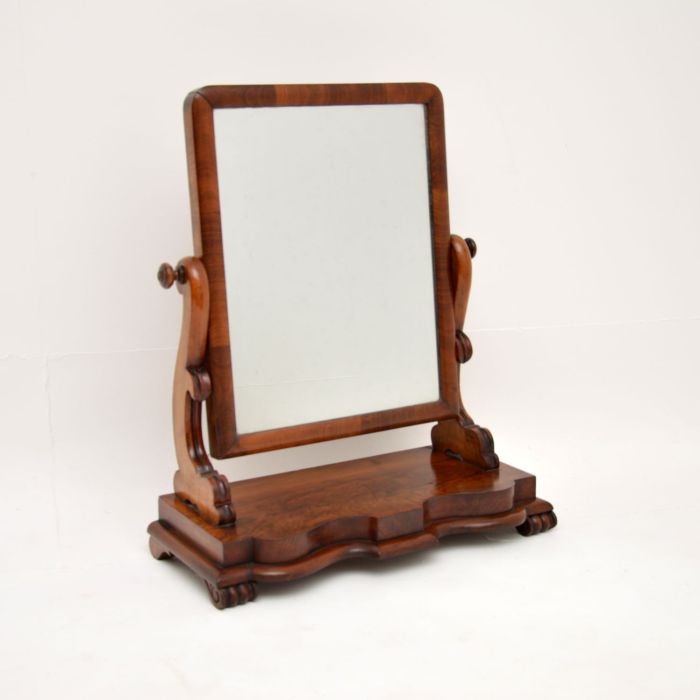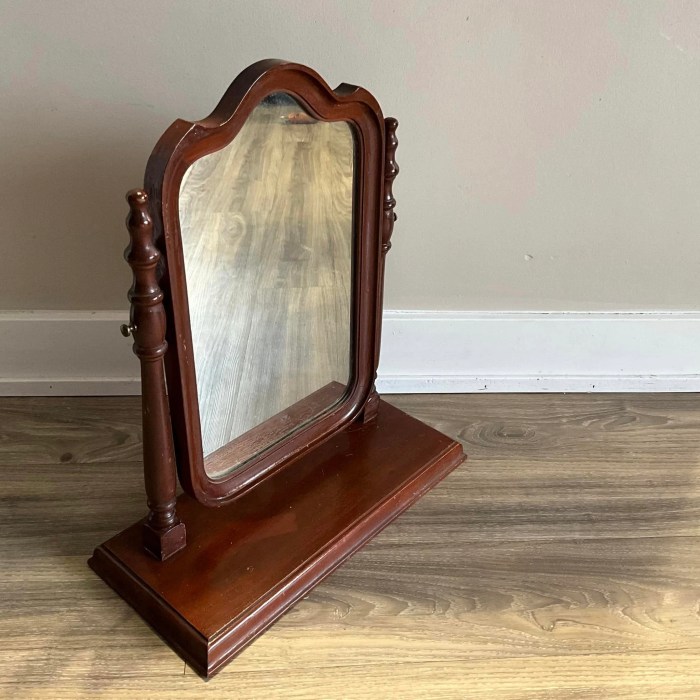Victorian classic vanity furniture with mirror: These elegant pieces represent a bygone era of refined craftsmanship and opulent design. From intricately carved details to gleaming mirrored surfaces, Victorian vanities offer a captivating glimpse into the aesthetic sensibilities of the 19th century. Their enduring appeal lies not only in their historical significance but also in their timeless beauty, capable of transforming a modern bathroom or bedroom into a sanctuary of classic charm.
This exploration delves into the history, design elements, and enduring legacy of these exquisite pieces.
The variety of styles within Victorian vanity furniture is remarkable. One might find ornate pieces crafted from mahogany or walnut, featuring elaborate carvings and inlaid designs. Others might showcase a more restrained elegance, emphasizing clean lines and polished surfaces. Regardless of the specific style, the incorporation of a mirror was a crucial element, reflecting not only the user’s image but also the surrounding elegance of the room.

The quality of the materials and the meticulous attention to detail are hallmarks of authentic Victorian vanities.
The Victorian era, spanning from 1837 to 1901, left an indelible mark on design aesthetics. Its influence is still visible today, particularly in the enduring elegance of Victorian furniture. Among the most captivating pieces from this period are the classic Victorian vanity tables with mirrors, exquisite examples of craftsmanship and style that continue to captivate collectors and homeowners alike.
Understanding the Allure of Victorian Vanity Tables
Victorian vanities weren’t merely functional; they were statements of personal style and wealth. Their intricate details, luxurious materials, and overall grandeur reflected the opulent tastes of the era. These vanities served as more than just a place to prepare for the day; they were focal points in boudoirs and bedrooms, showcasing the homeowner’s refined taste.
Key Characteristics of Victorian Vanity Furniture, Victorian classic vanity furniture with mirror
- Intricate Carving: Elaborate carvings were a hallmark of Victorian design. Expect to see intricate floral motifs, swirling acanthus leaves, and other ornate details adorning the vanity’s frame, legs, and even the mirror frame.
- Rich Materials: High-quality materials were essential. Common choices included mahogany, walnut, cherry, and rosewood. Inlays of mother-of-pearl, ebony, or other exotic woods were frequently used to enhance the piece’s visual appeal.
- Ornate Hardware: Brass or bronze hardware, often featuring decorative knobs, pulls, and escutcheons, added to the overall luxurious feel. These details were meticulously crafted and contributed significantly to the vanity’s aesthetic.
- Mirror Design: The mirrors themselves were often as elaborate as the vanity. They could be framed in carved wood, embellished with glass beveling, or even feature decorative elements like painted scenes or gilded accents. Triptych mirrors (three-part folding mirrors) were also popular.
- Styles and Variations: Victorian style encompassed a broad range of sub-styles, including Gothic Revival, Rococo Revival, and Eastlake, each influencing the design of vanities. This led to a wide variety of styles, from the darkly dramatic to the lighter, more ornate.
Identifying Authentic Victorian Vanity Tables
With the enduring popularity of Victorian-style furniture, many reproductions and imitations exist. Knowing how to identify an authentic piece requires careful examination.

Authenticity Clues:
- Construction Techniques: Examine the joinery. Dovetail joints, mortise and tenon joints, and other traditional joinery methods are indicative of higher-quality craftsmanship common in the Victorian era. Mass-produced pieces often employ simpler, less durable techniques.
- Wood Type and Age: The type of wood and its age can offer clues. Look for signs of aging, such as patina, minor scratches, and wear consistent with age. Authentic pieces will show signs of age, while reproductions may appear too pristine.
- Hardware and Finishes: Examine the hardware closely. Authentic Victorian hardware often shows signs of age and wear, and its quality will be superior to that found on modern reproductions. The finish should also appear consistent with the age of the piece.
- Maker’s Marks: Check for maker’s marks or stamps. These can help authenticate the piece and provide information about its origin and manufacturer. However, the absence of a maker’s mark doesn’t automatically disqualify a piece as authentic.
Caring for Your Victorian Vanity
Proper care is crucial for preserving the beauty and value of your Victorian vanity. Regular cleaning and maintenance will help protect it from damage and ensure its longevity.
Maintenance Tips:
- Dust Regularly: Use a soft, dry cloth or duster to remove dust regularly. Avoid harsh chemicals or abrasive cleaners.
- Polish Sparingly: Use a high-quality furniture polish specifically designed for antique or fine wood furniture. Apply sparingly and buff to a shine. Avoid over-polishing, which can damage the finish.
- Protect from Sunlight: Direct sunlight can fade the finish and damage the wood. Keep your vanity out of direct sunlight whenever possible.
- Avoid Extreme Temperatures and Humidity: Extreme temperature fluctuations and high humidity can warp the wood and damage the finish. Maintain a stable environment for your vanity.
- Repairing Damage: If your vanity requires repairs, consult a professional antique furniture restorer. Improper repairs can significantly diminish the value and integrity of the piece.
Victorian Vanity Styles and Variations
The Victorian era’s long span and diverse influences resulted in a wide array of vanity styles. Here are a few notable examples:
Specific Styles:
- Eastlake Vanity: Characterized by geometric forms, simple lines, and a rejection of excessive ornamentation. Often features turned legs and spindles.
- Gothic Revival Vanity: Features pointed arches, tracery, and other elements inspired by Gothic architecture. Often dark and dramatic in appearance.
- Rococo Revival Vanity: Embraces the ornate and flamboyant style of the Rococo period. Characterized by curved lines, shell motifs, and elaborate carvings.
- Aesthetic Movement Vanity: Emphasizes natural forms, handcrafted details, and a blend of styles. Often incorporates Arts and Crafts elements.
Finding and Purchasing a Victorian Vanity: Victorian Classic Vanity Furniture With Mirror
Acquiring a genuine Victorian vanity requires research and careful consideration. Here are some avenues to explore:
Where to Find Victorian Vanities:
- Antique Shops and Dealers: Antique shops and dealers specializing in Victorian furniture are excellent resources. They often have access to a wide selection of pieces and can provide expertise in authentication and restoration.
- Online Auction Sites: Online auction sites like eBay can offer a vast selection of Victorian vanities, but careful inspection and verification of authenticity are crucial.
- Estate Sales and Flea Markets: Estate sales and flea markets can be treasure troves of antique furniture, but require patience and a keen eye for detail.
- Antique Shows and Fairs: Antique shows and fairs provide opportunities to see a large selection of pieces and interact with knowledgeable dealers.
Frequently Asked Questions (FAQ)
- Q: How can I tell if a Victorian vanity is a genuine antique? A: Look for signs of age, traditional joinery techniques, high-quality materials, and maker’s marks. Consult with an expert if you are unsure.
- Q: How much does a Victorian vanity cost? A: The price varies greatly depending on the vanity’s condition, style, maker, and materials. Prices can range from a few hundred dollars to tens of thousands of dollars.
- Q: How do I clean a Victorian vanity? A: Use a soft, dry cloth for regular dusting. For more thorough cleaning, use a high-quality furniture polish specifically designed for antique furniture.
- Q: What are the most common types of wood used in Victorian vanities? A: Mahogany, walnut, cherry, and rosewood were frequently used.
- Q: Where can I find a reputable antique furniture restorer? A: Check online directories, ask for recommendations from antique dealers, or contact local historical societies.
References
- The Victorian Web (General information on the Victorian era)
- The Metropolitan Museum of Art (Collection of Victorian-era furniture)
- (Add other relevant links here, such as specific antique dealer websites or articles on Victorian furniture restoration)
Call to Action
Ready to add a touch of Victorian elegance to your home? Start your search for the perfect Victorian vanity today! Explore antique shops, online marketplaces, and estate sales to find the unique piece that complements your style. Remember to carefully examine any potential purchase to ensure authenticity and invest in proper care to preserve its beauty for years to come.
FAQ Section
What materials were commonly used in Victorian vanities?
Common materials included mahogany, walnut, cherry, and sometimes even more exotic hardwoods. Inlays of other materials, such as mother-of-pearl, were also frequent.
How can I identify a genuine Victorian vanity?

Look for hallmarks like intricate carvings, high-quality joinery, the use of specific hardwoods, and the overall level of craftsmanship. Researching period styles and comparing to known examples can also be helpful. Appraisals from experts are recommended for valuable pieces.
How do I care for a Victorian vanity?
Regular dusting with a soft cloth is essential. Avoid harsh chemicals and abrasive cleaners. For more significant cleaning, consult a professional furniture restoration specialist. Protect it from direct sunlight and extreme temperature fluctuations.
